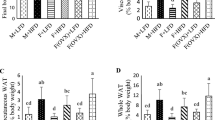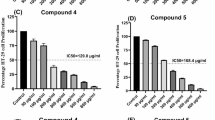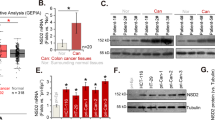Abstract
Epidemiological data suggest that oestrogen contributes to the aetiology of colonic cancer. Furthermore, recent studies have suggested that local hormone metabolism may play a key role in determining colonic responsiveness to oestrogen. To further clarify this mechanism we have characterized the expression and regulation of isozymes of 17β-hydroxysteroid dehydrogenase (17β-HSD) in vitro and in situ. Immunohistochemistry was used to confirm expression of the type 2 and 4 isozymes of 17β-HSD (17β-HSD2 and 4) in normal colonic epithelial cells. Parallel studies suggested that both isozymes were abnormally expressed in colonic tumours and this was confirmed by Western blot analyses. Abnormal expression of 17β-HSD2 and 4 proteins was also observed in Caco-2, HT-29 and SW620 colonic cancer cell lines, although the overall pattern of oestrogen metabolism in these cells was similar to that seen in primary colonic mucosal tissue. The predominant activity (conversion of oestradiol to oestrone) was highest in Caco-2>SW620>HT-29, which correlated inversely with the rate of proliferation of the cell lines. Regulatory studies using SW620 cells indicated that the most potent stimulator of oestradiol to oestrone inactivation was the antiproliferative agent 1,25-dihydroxyvitamin D3(1,25D3), whilst oestradiol itself inhibited 17β-HSD activity. Both oestradiol and 1,25D3decreased mRNA for 17β-HSD2 and 4. Data indicate that the high capacity for inactivation of oestrogens in the colon is associated with the presence of 17β-HSD2 and 4 in epithelial cells. Abnormal expression of both isozymes in colonic cancer cells and the stimulation of oestrogen inactivation by the antiproliferative agent 1,25D3highlights a possible role for 17β-HSD isozymes as modulators of colonic cell proliferation. © 2000 Cancer Research Campaign
Similar content being viewed by others
Article PDF
Change history
16 November 2011
This paper was modified 12 months after initial publication to switch to Creative Commons licence terms, as noted at publication
References
Brodie A, Lu Q and Long B (1999) Aromatase and its inhibitors. J Steroid Biochem Mol Biol 69: 205–210
Calle EE, Miracle-McMahill HL, Thun MJ and Heath, Jr CW (1995) Estrogen replacement therapy and risk of fatal colon cancer in a prospective cohort of postmenopausal women. J Natl Cancer Inst 87: 517–523
Colditz GA (1998) Relationship between estrogen levels, use of hormone replacement therapy, and breast cancer. J Natl Cancer Inst 90: 814–823
Di Domenico M, Castoria G, Bilancio A, Migliaccio A and Auricchio F (1996) Estradiol activation of human colon carcinoma-derived Caco-2 cell growth. Cancer Res 56: 4516–4521
Elo JP, Akinola LA, Poutanen M, Vihko P, Kyllonen AP, Lukkarinen O and Vihko R (1996) Characterization of 17beta-hydroxysteroid dehydrogenase isoenzyme expression in benign and malignant human prostate. Int J Cancer 66: 37–41
English MA, Kane KF, Cruickshank N, Langman MJS, Stewart PM and Hewison M (1999) Loss of estrogen inactivation in colonic cancer. J Clin Endocrinol Metab 84: 2080–2085
Fan L-Q, Cattley RC and Corton JC (1998) Tissue-specific induction of 17β-hydroxysteroid dehydrogenase type IV by peroxisome proliferator chemicals is dependent on the peroxisome proliferator-activator receptor α. J Endocrinol 158: 237–246
Fomitcheva J, Baker ME, Anderson E, Lee GY and Aziz N (1998) Characterization of ke6, a new 17 beta-hydroxysteroid dehydrogenase, and its expression in gonadal tissues. J Biol Chem 273: 22664–22671
Francavilla A, Dileo A, Polimeno L, Conte D, Barone M, Fanizza G, Chiumarulo C, Rizzo G and Rubino M (1987) Nuclear and cytosolic estrogen receptors in human colon carcinoma and in surrounding non-cancerous colonic tissue. Gastroenterol 93: 1301–1306
Hughes SV, Robinson E, Bland R, Lewis HM, Stewart PM and Hewison M (1997) 1,25-Dihydroxyvitamin D3 regulates estrogen metabolism in cultured keratinocytes. Endocrinol 138: 3711–3718
Jacobs E, Watson SA, Hardcstle JD and Robertson JFR (1996) Oestrogen and progesterone receptors in gastrointestinal cancer cell lines. Eur J Cancer 13: 2348–2353
Langman MJS (1967) Current trends in the epidemiology of cancer of the colon and rectum. Proc R Soc Med 60: 210–212
Maentausta O, Boman K, Isomaa V, Stendahl U, Backstrom T and Vihko R (1992) Immunhistochemical study of the human 17 beta-hydroxysteroid dehydrogenase and steroid receptors in endometrial adenocarcinoma. Cancer 70: 1551–1555
Mann VZ, Newton CJ and Tait GH (1991) 17β-hydroxysteroid dehydrogenases in human breast tissues: purification and characterization of soluble enzymes and the distribution of particulate and soluble forms in adipose, non-adipose and tumour tissues. J Mol Endocrinol 7: 45–55
McDonnell DP (1999) The molecular pharmacology of SERMs. Trends Endocrinol Metab 10: 301–311
McMichael AJ and Potter JD (1982) Colon cancer and sex hormones. Lancet 1: 1190–1192
Mehta RR and Das Gupta TK (1993) Regulation of 17 beta-hydroxysteroid dehydrogenase in a newly-established human breast carcinoma cell line. J Steroid Biochem Mol Biol 46: 623–629
Mountford JC, Bunce CM, Hughes SV, Drayson MT, Webb D, Brown G and Hewison M (1999) Estrone potentiates myeloid cell differentiation: A role for 17β-hydroxysteroid dehdrogenase in modulating haemopoiesis. Exp Hematol 27: 451–460
Mustonen MVJ, Poutanen MH, Kellokumpu S, de Launoit Y, Isomaa VV, Vihko RK and Vihko PT (1998) Mouse 17 beta-hydroxysteroid dehydrogenase type 2 mRNA is predominantly expressed in hepatocytes and in surface epithelial cells of the gastrointestinal and urinary tracts. J Mol Endocrinol Metab 78: 197–204
Newcomb PA and Storer BE (1995) Postmenopausal hormone use and risk of large bowel cancer. J Natl Cancer Inst 87: 1067–1071
O'Neill JS, Elton RA and Miller WR (1988) Aromatase activity in adipose-tissue from breast quadrants – a link with tumour site. BMJ 296: 741–743
Osborne CK (1998) Steroid hormone receptors in breast cancer management. Breast Cancer Res Treat 51: 227–238
Pasqualini JR, Chetrie G, Blacker C, Feinstein MC, Delelonde L, Talbi M and Maloche C (1996) Concentrations of estrone, estradiol and estrone sulfate and evaluation of sulfatase and aromatase activities in pre- and postmenopausal breast cancer patients. J Clin Endo Metab 81: 1460–1464
Peltoketo H, Isomaa V, Poutanen M and Vihko R (1996) Expression and regulation of 17β-hydroxysteroid dehydrogenase type 1. J Endocrinol 150: (Suppl): S21–S30
Peltoketo H, Vihko P and Vihko R (1999) Regulation of estrogen action: Role of 17 beta-hydroxysteroid dehydrogenase. Vitamins and Hormones 55: 353–398
Persson I, Yuen J, Bergvist L and Schairer C (1996) Cancer incidence and mortality in women receiving estrogen and estrogen-progestin replacement therapy – long term follow-up of Swedish cohort. Int J Cancer 67: 327–332
Puranen TJ, Kurkela RM, Lakkakorpi JT, Poutanen MH, Itaranta PV, Melis JPJ, Ghosh D, Vihko RK and Vihko PT (1999) Characterization of molecular and catalytic properties of intact and truncated human 17β-hydroxysteroid dehydrogenase type 2 enzymes: intracellular localization of the wild-type enzyme in the endoplasmic reticulum. Endocrinol 140: 3334–3341
Sasano H, Frost AR, Saitoh R, Harada N, Poutanen M, Vihko R, Bulun SE, Silverberg SG and Nagura H (1996) Aromatase and 17 beta-hydroxysteroid dehydrogenase type 1 in human breast carcinoma. J Clin Endocrinol Metab 81: 4042–4046
Singh S, Paraskeva C, Gallimore PH, Sheppard MC and Langman MJS (1994) Differential growth response to oestrogen of premalignant and malignant colonic cell lines. Anticancer Res 14: 1037–1042
Singh S, Poulsom R, Hanby AM, Rogers LA, Sheppard MC and Langman MJS (1998) Expression of oestrogen receptor and oestrogen-inducible genes pS2 and ERD5 in large bowel mucosa and cancer. J Pathol 184: 153–160
Takeyama J, Suzuki T, Hirasawa G, Muramatsu Y, Nagura H, Iinuma K, Nakamura J, Kimura K, Yoshihama M, Harada N, Andersson S and Sasano H (2000) 17β-hydroxysteroid dehydrogenase type 1 and 2 expression in the human fetus. J Clin Endo Metab 85: 410–416
Xu X and Thomas ML (1994) Estrogen receptor-mediated direct stimulation of colon cancer cell growth in vitro. Mol Cell Endo 105: 197–201
Author information
Authors and Affiliations
Rights and permissions
From twelve months after its original publication, this work is licensed under the Creative Commons Attribution-NonCommercial-Share Alike 3.0 Unported License. To view a copy of this license, visit http://creativecommons.org/licenses/by-nc-sa/3.0/
About this article
Cite this article
English, M., Hughes, S., Kane, K. et al. Oestrogen inactivation in the colon: analysis of the expression and regulation of 17 β -hydroxysteroid dehydrogenase isozymes in normal colon and colonic cancer. Br J Cancer 83, 550–558 (2000). https://doi.org/10.1054/bjoc.2000.1324
Received:
Revised:
Accepted:
Published:
Issue date:
DOI: https://doi.org/10.1054/bjoc.2000.1324
Keywords
This article is cited by
-
The prognostic impact of lipid biosynthesis-associated markers, HSD17B2 and HMGCS2, in rectal cancer treated with neoadjuvant concurrent chemoradiotherapy
Tumor Biology (2015)
-
Molecular cloning and expression of 17β-hydroxysteroid dehydrogenase type 2 gene in Hu sheep
Molecular Biology Reports (2013)
-
Oestrogen and colorectal cancer: mechanisms and controversies
International Journal of Colorectal Disease (2013)



